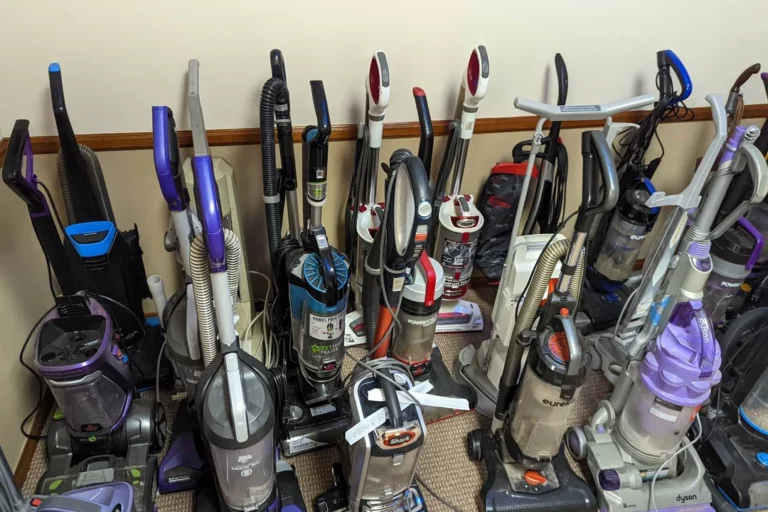
Quick Tips
Your vacuum works hard—sucking up dust, pet hair, and all the dirt you’d rather not think about. But have you ever thought about cleaning your vacuum? A clogged filter, tangled roller, or blocked hose means your vacuum is doing half the work with twice the effort. If your vacuum smells weird, isn’t picking up debris like it used to, or just seems louder than usual, it’s time for a deep clean. Here’s how to clean a vacuum cleaner and every essential part of your vacuum so it runs like new.
Why Cleaning Your Vacuum is Essential
A vacuum cleaner is only as good as its maintenance. Over time, dust builds up in filters, hair and string wrap around rollers, and hidden clogs in the hose reduce suction power. A dirty vacuum not only works inefficiently but can also recirculate dust and allergens back into the air. Regular cleaning ensures your vacuum maintains strong suction, lasts longer, and keeps your home as clean as possible.
What You’ll Need
- Scissors or Seam Ripper – For cutting tangled hair and string from rollers.
- Mild Dish Soap – To clean filters and dust bins.
- Warm Water – Essential for rinsing components.
- Microfiber Cloths – To wipe down exterior surfaces.
- Soft Brush or Toothbrush – For scrubbing debris from filters and rollers.
- Compressed Air (Optional) – Helps dislodge dust from small crevices.
- Pipe Cleaner or Long Brush – For clearing blockages in the hose.
- Screwdriver (if needed) – Some rollers or filters require a tool for removal.
How to Clean a Vacuum Cleaner in 6 Steps
1. Empty and Clean the Dust Bin or Bag
If your vacuum has a bag, replace it when it’s about two-thirds full—don’t wait until it’s completely packed. For bagless models, remove the dust bin and empty it into the trash. Wash the dust bin with warm, soapy water and let it dry completely before reattaching it. A clean dust bin prevents lingering odors and keeps your vacuum’s airflow clear.
Cleaning the Filters
2. Remove and Wash the Filters
Most vacuums have one or more filters—usually a pre-motor filter and a HEPA filter. Check your vacuum’s manual for exact locations. Remove the filters and tap them against a trash can to shake out loose dust. If they’re washable, rinse them under warm water and use mild dish soap if needed. Let them air dry for at least 24 hours before reinstalling them. Never put a damp filter back in your vacuum—it can lead to mold growth and a nasty smell.
3. Check for Replaceable Filters
Some vacuums use replaceable filters instead of washable ones. If your filter looks discolored or clogged even after shaking it out, it’s time for a replacement. Most manufacturers recommend changing filters every three to six months for optimal performance.
Cleaning the Rollers
4. Remove and Detangle the Brush Roll
Turn the vacuum upside down and locate the roller brush. Some models allow you to remove the roller with a quick-release button, while others may require a screwdriver. Once removed, use scissors or a seam ripper to cut through hair and fibers wrapped around the roller. Be careful not to damage the bristles. Wipe down the roller with a damp microfiber cloth to remove stuck-on debris.
5. Check the Bearings for Debris
Hair and dirt can build up in the bearings at both ends of the roller. If the brush roll is difficult to spin, remove the end caps (if possible) and clean out any debris. A small amount of lubricant on the bearings can help keep the roller spinning smoothly.
Cleaning the Hoses
6. Clear Clogs from the Hose
A clogged hose reduces suction power, making your vacuum far less effective. Detach the hose from the vacuum and check for visible blockages. Use a long brush, pipe cleaner, or even a broom handle to push out debris. If the clog is stubborn, try running warm, soapy water through the hose and letting it dry completely before reattaching it.
7. Inspect and Wipe Down the Hose Exterior
While the hose is detached, wipe down the outside with a damp microfiber cloth to remove dust and grime. Check for cracks or tears—if your hose has a hole, even small, it can significantly reduce suction and may need replacing.
Preventative Maintenance: Keeping Your Vacuum Running Strong
- Clean the filters monthly – If your vacuum has washable filters, rinse them regularly.
- Check the roller brush weekly – Tangled hair and debris build up quickly.
- Empty the dust bin after every use – This prevents odors and keeps airflow strong.
- Inspect the hose regularly – A small blockage can dramatically reduce suction.
- Store your vacuum properly – Avoid wrapping the cord too tightly, which can damage internal wiring.
Common Mistakes to Avoid
- Not letting filters dry completely before reinstalling – This leads to mold and musty smells.
- Using harsh chemicals on plastic parts – Stick to mild dish soap to prevent damage.
- Ignoring strange noises – A rattling sound could mean a blockage or something stuck in the brush roll.
- Neglecting the power cord – Frayed or damaged cords are safety hazards and should be replaced immediately.
Final Thoughts
A well-maintained vacuum is a powerful vacuum. Regularly cleaning the filters, rollers, and hoses not only ensures better suction and efficiency but also extends the life of your machine. By following these steps, your vacuum will continue to pick up dirt effectively instead of just pushing it around. If you’re deep-cleaning your appliances, check out How to Clean an Air Fryer for another essential kitchen maintenance guide.
Sources Cited